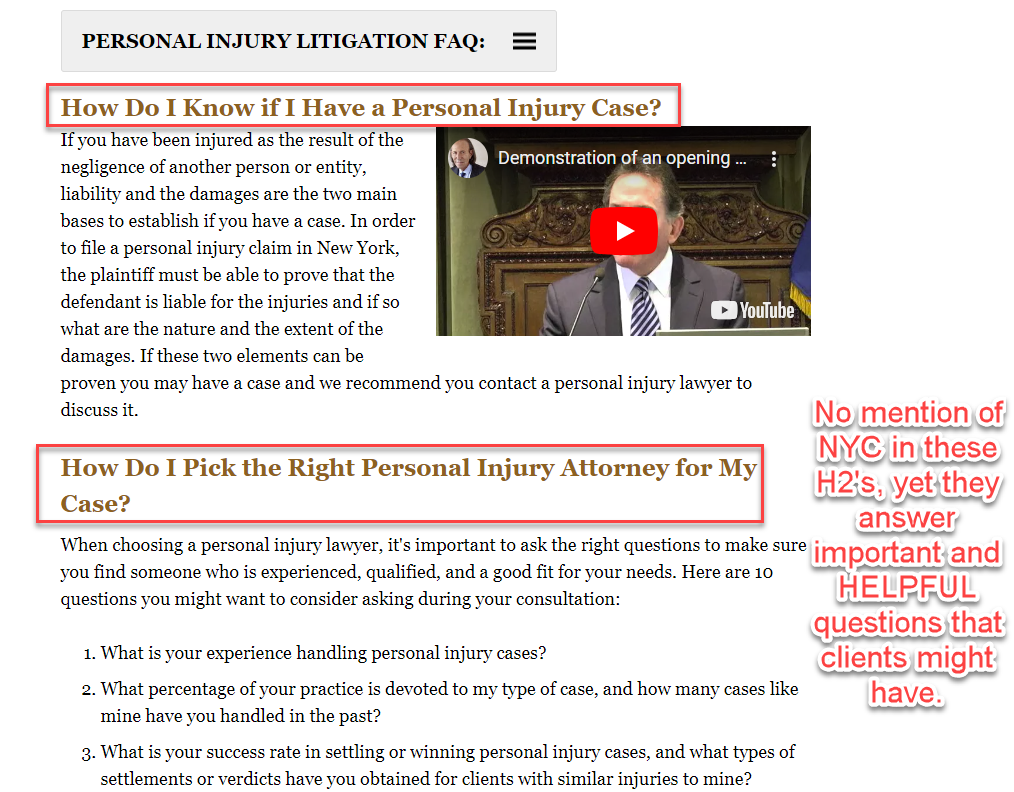Keyword stuffing is the overuse of keywords on a specific webpage to manipulate search engine rankings. It is a spammy tactic that typically looks and feels unnatural, and Google frowns on it.
Not only does keyword stuffing look very spammy, but it’s also bad for your SEO. It makes it more difficult for users to interact with your website content and leads to an overall poor user experience, an important ranking factor.
The best way to showcase what keyword stuffing looks like and how to utilize keywords properly is to share an example of what to do versus what not to do.
Looking for help with your website’s SEO? Contact The Media Captain!
Example of Keyword Stuffing
We’ve all been there before. We hit a webpage, and the headlines are stuffed with the same or similar keyword queries. In the screenshot below, the H1, or headline one: “NYC personal injury lawyers”. Moving down from there, you can see different variations of the same keywords multiple times. I’ve circled just the instances from the first two sections on the homepage. As you keep scrolling, you can see that these keywords continue repeating. This would be an example of keyword stuffing. Although utilizing these same phrases seems somewhat natural, after all, these are personal injury attorneys, they are really pushing the limit with the use of these phrases.
Related Blog: SEO Strategy for Personal Injury Lawyers
How Helpful Content Correlates with Keyword Stuffing
You can’t mention keyword stuffing without talking about helpful content. Google is now penalizing websites that have unhelpful content and provide a poor experience for the user, and they’re rewarding those that have helpful experiences for the user. And so, if you’re just stuffing keywords into your headlines and onto the copy of your webpage, this is not providing a helpful experience to your end user. Make sure to be very careful about over-optimizing and keyword stuffing.
Related Blog: What’s Thin Content and How Do You Fix It to Improve SEO?
The 35% Rule for Heading Optimization
Let’s dive into my 35% rule. Google still indexes keywords and prioritizes headlines to understand what a webpage is all about. If you want to rank well, you must incorporate a keyword onto that webpage, but it also can’t be over-optimized. You need to find that happy medium, and that’s where my 35% rule comes into play. If you have ten headlines, three or four of those, around 35%, should incorporate keywords, whereas the others should be prioritized for user experience.
Example of PI Attorney Crushing Headline & Incorporation
The New York City personal injury lawyer below ranks number one overall on Google for the extremely competitive query “NYC personal injury lawyer.” They are also doing a great job following the 35% rule. You’ll see below that in the H1, the most important heading from an SEO perspective, they have that keyword: “Hiring a New York Personal Injury Lawyer.”
Related Blog: How To Properly Optimize Headings to Improve SEO
Scrolling down the page, you come to the headline, “How do I know if I have a personal injury case?” Here, there’s no reference to NYC. It has good readability and answers a question that potential clients are likely asking, making this very helpful content. The next headline is “How do I pick the right personal injury attorney for my case?” Again, that’s something people are curious about, so it has strong readability.
They sprinkle in “What damages are subject to compensation in a NY personal injury case?” plus several other NY and NYC references, but it’s not overly stuffed. Most importantly, they provide extremely helpful, frequently asked questions to potential clients. Overall, the page has strong readability, and guess what? They’re ranking number one on Google.
Related Blog: What’s Thin Content and How Do You Fix It to Improve SEO?
Closing Out
When optimizing a webpage, you want to ensure a great experience. You can’t do that if all the headlines are stuffed with keywords and not created for readability. Yet simultaneously, you want to sprinkle some keywords in for SEO success. Finding the perfect balance can be difficult, but following my 35% rule can help you out.
Subscribe to The Media Captain on YouTube.






